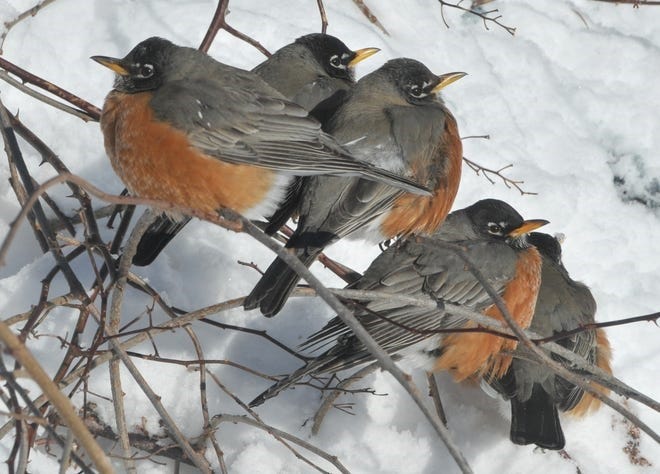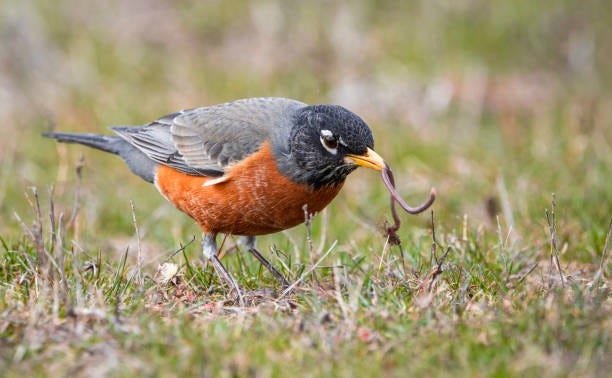Color on a winter canvas
February 27, 2024. I glance out my window toward my distant birdbath and see an unexpected flash of color—a lovely, orangish red that I haven’t seen since sometime last fall. I grab my binoculars and feast my eyes on an American Robin. And another. And another. They drop from the surrounding pine trees like large, fluttering leaves, then cluster around the bath, dipping their bills into the water to drink. The first robins of the new year. An ordinary, common backyard bird that has added a splash of color to my winter-white landscape, lifted my spirits, and made them sing. Minutes before there were none. And now I can’t keep track of them all as they land on tree branches, hop around on the ground, and jostle for their spot at the now-crowded bird bath. Ten minutes later, they are gone.
Even the most common birds can fascinate and delight. And every bird tells a story. These 30 or so migrating robins spotted the activity at my remote bird-feeding area while flying to wherever the flock was going, and stopped in to rest and refuel. The flurry of robins sparks a flurry of questions in my mind: Where have they come from? Where are they going? Where did they spend the winter? How far have they traveled?
Robins are beloved harbingers of spring in many parts of the country (some of you are fortunate enough to have them year-round), but they are also canaries in the coalmine, alerting us to environmental harms. Shocking numbers of robins convulsing and dying on Midwest lawns beginning in 1955 helped alert us to the perils of the pesticide DDT. Trees had been sprayed with DDT to control Dutch elm disease the previous spring, earthworms had later consumed the fallen leaves, and robins then consumed the earthworms.
Today, common birds are telling us a no-less alarming story, but in a more subtle way: through their declining numbers. And a new class of pesticides—known as neonicotinoids—is at least partially responsible. Neonics are absorbed into plant leaves, fruits, and flowers, and are highly toxic to insects. They also harm birds and other creatures. Because of widespread neonic use, insects are disappearing, leaving less food for birds and their young. So birds are disappearing too. It’s a problem we can solve if we choose. In the meantime, some of our birds are still here, lighting up our waning winter days, and heralding the start of a green new spring.
Take a small step to help birds
It is easy to feel helpless in the face of climate change, habitat destruction, and disappearing wildlife. But according to the US Fish and Wildlife Service, over 96 million people in North America watch birds. If each of us does something to help them, we may be able to reverse their declining numbers.
Here are a few things you can do:
Be like a robin: Eat berries! (I’d forego the worms.) But buy organic ones if you can. Neonicotinoid pesticides are absorbed into plant fruits, so you cannot wash them off. Organic farming is better for birds, better for us, and better for our environment.
If you have a lawn, try to plant grass seed that is NOT coated with insecticides and herbicides. I once sowed a type of seed (on my very tiny lawn) that was dyed blue. I quite liked what I thought was innocuous dye because I could more easily see how I had spread the seeds. But later I realized, to my chagrin, that the seeds were coated with neonicotinoids, which harmed the very soil organisms I wanted to sustain.
Try to refrain from using pesticides and herbicides around your home to protect your resident robins and other birds from eating contaminated organisms.
Thank you for reading and thanks for helping birds!
Until next time …
P.S. For more information about DDT, neonicotinoids, and the stories birds tell us, please check out my new book Feather Trails—A Journey of Discovery Among Endangered Birds, which will be published May 2, 2024, and is available for pre-order on Amazon. This page now includes some reviews of my book.






Kris! I'm so happy you found me! You know both the joys and the bureaucracy first hand. I'm glad I can give you a bit of the former when you're buried in the latter. : )
Thanks for sharing this with me! I hadn't seen it and it IS a fascinating read. It's great when new technologies add to our ever-evolving understanding (and appreciation) of the complexities of bird behavior.